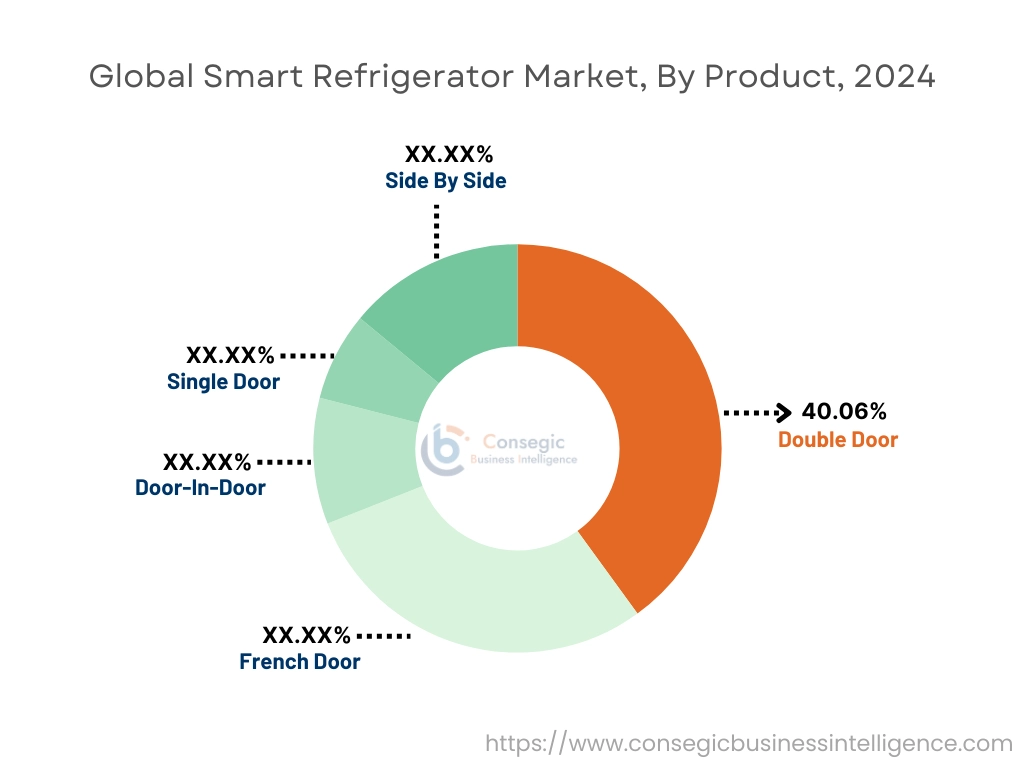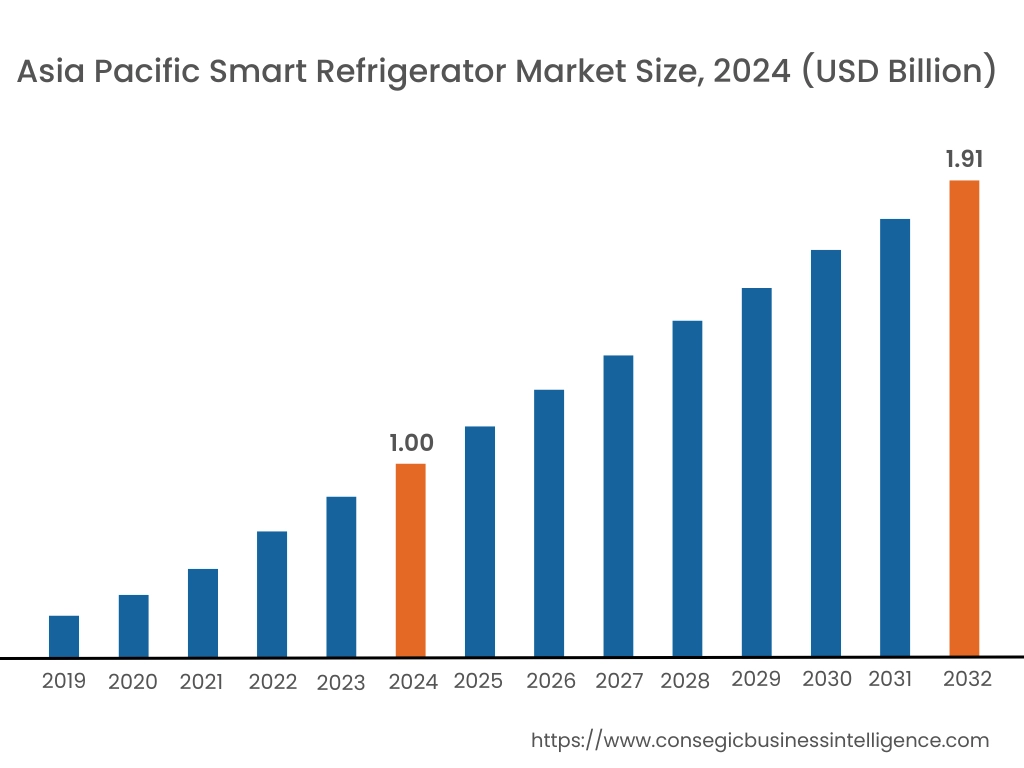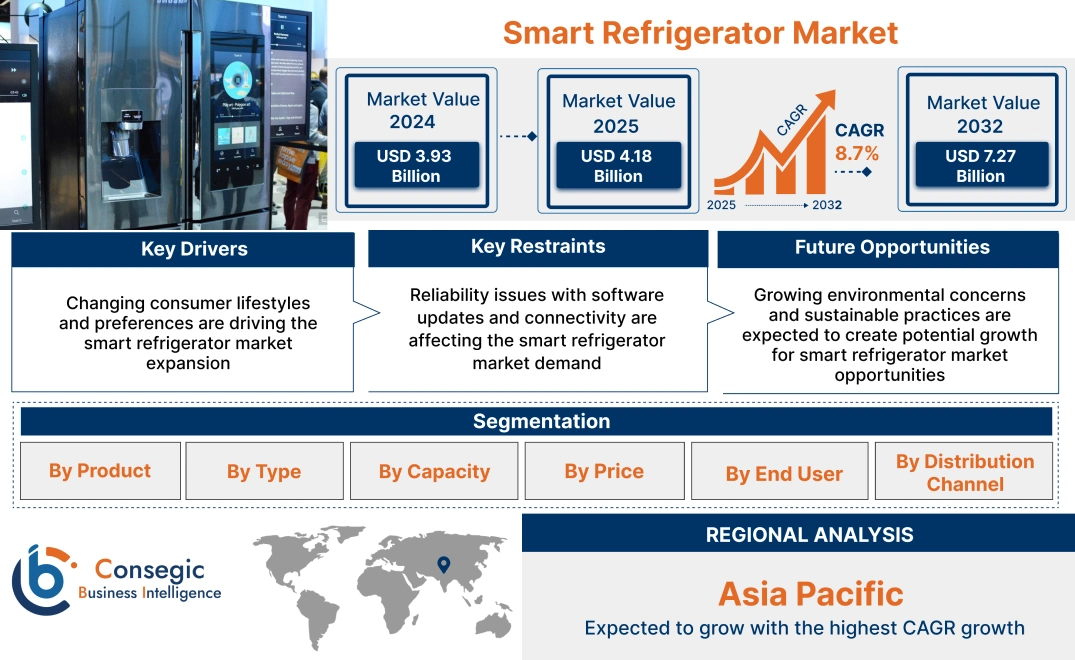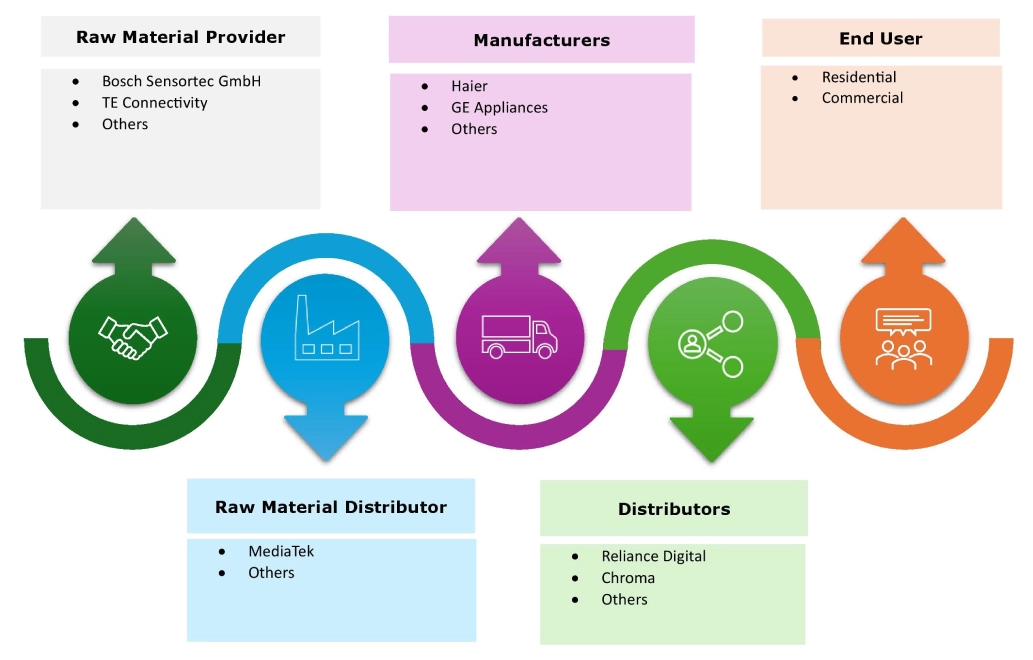- Summary
- Table Of Content
- Methodology
Smart Refrigerator Market Size:
Smart Refrigerator Market Size is estimated to reach over USD 7.27 Billion by 2032 from a value of USD 3.93 Billion in 2024 and is projected to grow by USD 4.18 Billion in 2025, growing at a CAGR of 8.7% from 2025 to 2032.
Smart Refrigerator Market Scope & Overview:
Smart refrigerator, also known as connected refrigerators or intelligent refrigeration systems, integrate advanced technologies such as IoT sensors, Wi-Fi connectivity, touchscreen displays, and AI (Artificial Intelligence) algorithms to offer users superior convenience, efficiency, and control over their refrigeration experience. These appliances offer advanced food preservation functions, along with streamlining meal planning, grocery management, recipe suggestions, and energy optimization in residential kitchens. As consumers embrace connected lifestyles and seek seamless integration of smart devices into their homes, the need for smart fridges that offer remote monitoring, voice control, and interoperability with other smart home devices continues to rise, in turn driving the market.
Key Drivers:
Changing consumer lifestyles and preferences are driving the smart refrigerator market expansion
Changing consumer lifestyles and preferences play a significant role in driving the global market. With evolving lifestyles, consumers are increasingly seeking convenience and efficiency in their daily lives. As a result, there is a growing demand for refrigerators with advanced features such as larger storage capacities, flexible storage options, and innovative organizational features. Additionally, consumers are placing greater emphasis on food preservation and freshness, leading to the adoption of refrigerators equipped with advanced cooling technologies and humidity control systems to prolong the shelf life of perishable goods.
Changing preferences towards healthier eating habits and the increasing awareness of food safety are influencing consumer choices in refrigerators. Consumers are opting for refrigerators with features that facilitate the storage of fresh produce, including fruits, vegetables, and dairy products, at optimal temperatures to maintain nutritional value and minimize food waste. As a result, manufacturers are focusing on developing refrigerators with specialized compartments, such as humidity-controlled drawers and dairy bins, to cater to these evolving consumer preferences.
- For instance, in March 2025, Samsung Electronics Co., Ltd. introduced its 4-Door and side-by-side refrigerators. Samsung's latest refrigerators feature user-friendly 9-inch AI home screens and 21.5-inch family hub screens, specifically designed to improve four essential aspects of daily life, including food management, home control, family communication, and entertainment.
Thus, according to the smart refrigerator market analysis, the changing consumer lifestyles, combined with growing advancements related to smart fridges are driving the smart refrigerator market size.
Key Restraints:
Reliability issues with software updates and connectivity are affecting the smart refrigerator market demand
Reliability issues associated with software updates and connectivity pose a significant restraint in the global market, hindering seamless functionality and user experiences. As smart refrigerators rely on software systems and internet connectivity to deliver advanced features and remote monitoring capabilities, any disruptions or inconsistencies in these components can undermine the reliability and performance of the appliance.
While software updates are intended to enhance functionality, address security vulnerabilities, and introduce new features, they can sometimes introduce bugs, glitches, or compatibility issues that affect the overall performance of the appliance. Users may encounter issues such as system crashes, frozen screens, or loss of connectivity following a software update, decreasing trust in the reliability of the smart fridge and creating a negative user experience. Thus, the above analysis depicts that the aforementioned factors would further impact on smart refrigerator market size.
Future Opportunities :
Growing environmental concerns and sustainable practices are expected to create potential growth for smart refrigerator market opportunities
Environmental concerns and sustainability issues present significant opportunities for the global market. As consumers become more environmentally conscious, there is a growing demand for eco-friendly appliances that have a minimal impact on the environment throughout their lifecycle. This trend has prompted manufacturers to develop refrigerators with improved energy efficiency, reduced greenhouse gas emissions, and eco-friendly features, thereby aligning with sustainable development goals and environmental regulations.
Manufacturers are increasingly incorporating recycled materials into their products and implementing more sustainable production methods to reduce carbon footprint and minimize waste generation. By adopting sustainable practices, companies can enhance their brand image, attract environmentally-conscious consumers, and attain a competitive edge in the market.
- For instance, in November 2023, Whirlpool Corporation introduced SlimTech technology in refrigerator for the North American market. It is a vacuum insulated structure technology, which reduces the wall thickness up to 66% and allowing more 25% more capacity inside the refrigerator. This refrigeration innovation offers a range of advantages, such as higher efficiency, quieter operation, and increased design flexibility, while also presenting prospects for a more sustainable approach.
Thus, based on the above smart refrigerator market analysis, the growing environmental concerns and sustainable practices are expected to drive smart refrigerator market opportunities.
Smart Refrigerator Market Segmental Analysis :
By Product:
Based on product, the smart refrigerator market is segmented into single door, double door, french door, door-in-door, and side by side.
Trends in the product:
- Modern refrigerators often incorporate energy-efficient components and eco-friendly refrigerants to minimize environmental impact and reduce energy consumption.
- The segment growth can be attributed to the proliferation of smart home ecosystems, increasing consumer demand for convenience-driven appliances, growing awareness of food waste reduction, and technological advancements in sensor technology, data analytics, and cloud computing.
The double door segment accounted for the largest revenue share of 40.06% in the year 2024.
- Double door refrigerators, also known as top freezer refrigerators, consist of two separate compartments, one for refrigeration and the other for freezing, stacked on top of each other.
- These fridges offer several benefits such as simplicity, reliability, and affordability, making them a popular choice among budget-conscious consumers.
- Smart double door refrigerators integrate modern technology to offer features such as remote temperature monitoring, voice control, and adaptive cooling systems, enhancing user experiences and energy efficiency.
- For instance, in August 2024, Samsung introduced AI double door fridge series with expanded AI features. The new AI double-door refrigerator series, featuring 396L, 419L, and 465L models, will be priced from INR 64,990 (USD 774.87) and offers significant convenience, storage capacity, and flexibility.
- Thus, based on the above analysis, these factors are further driving the smart refrigerator market growth.
The French door segment is anticipated to register the fastest CAGR during the forecast period.
- French door refrigerators combine the convenience of side-by-side design with the elegance of double doors, featuring two adjacent doors for the refrigerator section and a bottom freezer drawer.
- These refrigerators offer spacious interiors, customizable storage options, and advanced features such as temperature-controlled compartments, water and ice dispensers, and built-in cameras for inventory management.
- Smart french door refrigerators elevate the user experience with intuitive interfaces, smart home integration, and AI-powered functionalities, making them a better choice among selective consumers seeking luxury and innovation in their kitchen appliances.
- For instance, LG’s 614 litre French door refrigerator has AI ThniQ, which features smart inverter compressor technology for energy efficiency.
- Thus, based on the above analysis, these factors are expected to drive the smart refrigerator market share during the forecast period.

By Type:
Based on type, the market is segmented into countertop and freestanding.
Trends in the type:
- Technological advancements have led to the development of energy-efficient and eco-friendly refrigerators, aligning with global sustainability goals.
- Manufacturers in the market are continuously innovating to enhance the efficiency, sustainability, and functionality of both refrigerator and freezer counters. This includes advancements in insulation technologies, energy-efficient designs, and smart cooling systems that optimize storage space and operational performance.
The freestanding segment accounted for the largest revenue in the year 2024.
- Freestanding refrigerators are a popular choice due to their diverse styles and simple installation, and ability to meet various consumer needs.
- Their appeal is further enhanced by advanced features like touchscreen controls, smart functionalities, and energy-saving capabilities. Unlike built-in models, they offer greater flexibility in placement.
- This combination of functionality, innovative features, and ease of setup positions freestanding refrigerators as the better option for modern homes seeking adaptable and up-to-date appliances.
- Thus, based on the above analysis, these factors would further supplement the global market share.
The countertop segment is anticipated to register fastest CAGR during the forecast period.
- The countertop solutions minimize the environmental footprint of refrigeration systems by reducing energy consumption, emissions of greenhouse gases, and the use of harmful refrigerants.
- Natural refrigerants like hydrocarbons (propane, isobutane), ammonia, and carbon dioxide are being increasingly utilized in refrigerated counters due to their environmentally friendly properties and compliance with regulatory guidelines aimed at phasing out high-global warming potential (GWP) refrigerants.
- Businesses across various sectors, including retail, food service, and healthcare, are increasingly selecting refrigerated counters that align with their corporate sustainability goals and demonstrate commitment to environmental stewardship.
- These developments in the countertop refrigerators are anticipated to further drive the smart refrigerator market trends during the forecast period.
By Capacity:
Based on capacity, the market is segmented into small (10-19 cubic feet), medium (20-29 cubic feet), and large (30+ cubic feet).
Trends in the capacity:
- Changes in household structures and family sizes are creating a greater demand for refrigerators with increased storage capacity to hold more groceries and perishable foods.
- The prevailing global shift towards nuclear family structures has led to a preference for mid-capacity refrigerators equipped with integrated freezers for residential use.
The small (10-19 cubic feet) segment accounted for the largest revenue share in the year 2024.
- Refrigerators with a capacity of less than 15 cubic feet are designed for compact spaces, including small apartments, dormitories, and single-person households.
- These models are energy-efficient and cost-effective, making them popular in urban areas with space constraints.
- Additionally, advancements in cooling technology have improved their performance, ensuring optimal food preservation despite their smaller dimension.
- Thus, based on the above analysis, these factors are driving the smart refrigerator market growth.
The medium (20-29 cubic feet) segment is anticipated to register the fastest CAGR during the forecast period.
- Refrigerators with medium capacity offer a balance between storage capacity and affordability, making them the preferred choice for the majority of consumers worldwide.
- These models often come equipped with advanced features such as adjustable shelving, multi-zone cooling, and smart connectivity, enhancing user convenience.
- The growing urbanization and changing food consumption patterns, such as increased reliance on frozen and fresh food storage, are further fuelling the demand in this segment.
- These factors are anticipated to further drive the smart refrigerator market trends during the forecast period.
By Price:
Based on price, the smart refrigerator market is segmented into low, medium, and high.
Trends in the price:
- With growing e-commerce platforms, consumers can browse a wide selection of refrigerators, compare prices and features, read reviews, and make purchases. These factors are further driving the segment.
- Retail channels often provide access to exclusive deals, discounts, and promotions, further enhancing their appeal to price-conscious consumers.
The low segment accounted for the largest revenue in the year 2024.
- The low-price range caters to budget-conscious consumers. Products in this segment typically focus on functionality and durability over advanced features or premium materials.
- The middle-class population often prefer to start with less expensive equipment before committing to higher-end consumer electronics. This fuels the need for economy-priced items.
- Consumers are increasingly conscious of energy consumption, driving demand for energy-efficient models. This leads to increasing adoption of economical refrigerators with improved energy star ratings.
- Therefore, these the above factors are driving the global market.
The medium segment is anticipated to register the fastest CAGR during the forecast period.
- Consumer in this segment are seeking devices that offers improved performance, comfort, and longevity.
- Established brands such as Samsung and Whirlpool have a strong presence in mid-range segment, while attracting consumers who trust brands for quality and reliability.
- Consumers in this segment consider the long-term cost of ownership. Mid-range equipment is generally built to last longer than economy options, reducing the need for frequent replacements.
- These factors are anticipated to further drive the smart refrigerator market expansion during the forecast period.
By End User:
Based on end user, the market is segmented into residential and commercial.
Trends in the end user:
- Manufacturers are increasingly incorporating recycled materials into their products and implementing more sustainable production methods to reduce carbon footprint and minimize waste generation. By adopting sustainable practices, companies can enhance their brand image, attract environmentally-conscious consumers, and gain a competitive edge in the market.
- Businesses in the food industry, including restaurants, hotels, and grocery stores, are adopting intelligent refrigerators to streamline their operations. These smart fridges help reduce food waste, boost customer satisfaction, and increase profits by offering features like temperature control, energy usage monitoring, and remote troubleshooting.
The residential segment accounted for the largest revenue in the year 2024.
- Residential smart fridges are designed for everyday household use, offering consumers enhanced convenience and connectivity features.
- These refrigerators typically include functionalities such as temperature control via smartphone apps, voice assistant integration, energy efficiency, and inventory management.
- The increasing need for smarter homes and the growing adoption of IoT-connected devices contribute to the popularity of smart fridges in residential settings.
- Homeowners value the ability to monitor and adjust their refrigerator remotely, receive alerts for maintenance or expiry dates of stored food, and even create shopping lists based on inventory tracking. These features enhance convenience, save energy, and contribute to improved food management for busy households.
- For instance, in March 2021, Haier Smart Home launched new smart refrigerator. The appliance adheres to a comprehensive set of regulations, meeting both 22 Chinese standards and the internationally recognized IEC Standards, which were co-developed with Haier to guarantee safety, efficiency, and environmental responsibility in refrigeration.
- Therefore, these the above factors are driving the smart refrigerator market demand.
The commercial segment is anticipated to register the fastest CAGR during the forecast period.
- Commercial smart fridges cater to businesses and industries such as restaurants, hotels, grocery stores, and medical facilities, where precise temperature control and efficient storage management are crucial.
- These fridges often come with advanced sensors, real-time monitoring, and automated alerts to ensure food safety, particularly in environments where compliance with health regulations is a top priority.
- In commercial settings, smart fridges are used to store perishable goods such as dairy, meats, and pharmaceuticals, where maintaining optimal temperature conditions is essential to prevent spoilage or loss of quality.
- Additionally, commercial smart fridges may integrate with broader inventory management systems, improving operational efficiency and reducing waste by tracking product usage and stock levels in real-time.
- These factors are anticipated to further drive the market during the forecast period.
By Distribution Channel:
Based on the distribution channel, the market is segmented into online and offline.
Trends in the distribution channel:
- Online and offline shopping are increasingly popular for its convenience and research capabilities, as consumers still value the in-person experience of examining high-value items like refrigerators before purchase.
- Retail stores offer benefits such as personal assistance and immediate delivery, which are essential for building trust and strong customer relationships.
- Conversely, online platforms are preferred for their ease of comparing prices, exploring models, and reading reviews, along with the appeal of online discounts.
The offline segment accounted for the largest revenue in the year 2024.
- Offline stores include traditional retail outlets such as electronics stores, home appliance stores, and supermarkets. These physical stores continue to be important in the smart fridge market, particularly for customers who prefer to interact with products in person before making a purchase.
- The ability to touch, feel, and test the features of smart fridges, such as smart cooling technology, touchscreen interfaces, and connectivity options, is a key benefit of offline shopping.
- Additionally, these stores offer personalized assistance from sales representatives, helping consumers make informed decisions based on their needs, which is valuable for high-investment products like smart fridges.
- Furthermore, offline stores provide immediate availability, which is important for customers who need a fridge urgently.
- Thus, based on the above factors, these developments in the offline segment are driving the global market.
The online segment is anticipated to register the fastest CAGR during the forecast period.
- Consumers increasingly prefer shopping online due to the convenience of browsing a wide variety of models, comparing prices, and reading detailed product reviews from other buyers.
- E-commerce platforms such as Amazon, Best Buy, and Walmart, as well as manufacturer websites, allow customers to easily find and purchase smart fridges without leaving their homes.
- Online stores offer the added benefit of home delivery, which can save consumers the hassle of transporting large appliances themselves.
- In addition, online retailers often offer exclusive online promotions, discounts, and financing options that further incentivize purchases.
- The rise of online shopping is particularly appealing for customers who are already familiar with smart home devices and are comfortable purchasing large household appliances through digital channels.
- These factors are anticipated to further drive the global market during the forecast period.
Regional Analysis:
The global market has been classified by region into North America, Europe, Asia-Pacific, Middle East Africa, and Latin America.

Asia Pacific mobility as a service market expansion is estimated to reach over USD 1.91 billion by 2032 from a value of USD 1.00 billion in 2024 and is projected to grow by USD 1.06 billion in 2025. Out of this, the China market accounted for the maximum revenue split of 35.04%. The Asia Pacific region encompasses key markets such as China, Japan, India, South Korea, and Australia, representing a dynamic and rapidly growing market for smart fridges, which is driven by urbanization, rising disposable incomes, and technological advancements. Consumers in Asia Pacific seek smart fridges that offer innovative features, affordability, and compatibility with smart home ecosystems, fueling the need for connected appliances that enhance convenience and efficiency in modern kitchens. These factors would further drive regional smart refrigerator market share during the forecast period.
- For instance, in October 2021, Whirlpool India launched W Series range of premium 4 door refrigerators. These large refrigerators utilize advanced technologies, including adaptive intelligence and triple cooling, to deliver an exceptional user experience by maintaining ideal temperatures and preserving food freshness for extended periods.

North America market is estimated to reach over USD 2.60 billion by 2032 from a value of USD 1.41 billion in 2024 and is projected to grow by USD 1.50 billion in 2025. Refrigerator manufacturers in the region are constantly improving their systems to reduce energy use. Innovations such as advanced defrosting, efficient compressors, and low-power modes are contributing to this trend. Furthermore, brands like Liebherr, SunFrost, and Sub-Zero have implemented dual refrigeration systems, using separate compressors for the refrigerator and freezer compartments, which optimizes cooling and minimizes energy consumption. Further, the need for larger, more versatile refrigerators with customizable storage, multi-door designs, and advanced food preservation features is growing. These factors would further drive the regional market.
- For instance, in January 2024, Liebherr introduced new wine fridges featuring precise humidity control. It allows users to adjust the moisture levels in 5% increments, ranging from 50% to 80% relative humidity, to perfectly suit their wine storage needs.
Additionally, according to the analysis, the smart refrigerator industry in Europe is expected to witness significant development during the forecast period. As population become increasingly concentrated in urban areas, lifestyle shifts are driving the regional market growth. In European countries with high urbanization rates, such as Malta, United Kingdom, and Netherlands, where a significant majority of residents live in cities, there is a strong need for household appliance accessories. Additionally, the rising consumer spending in the home appliance sector in Latin American countries is showing significant growth, which has led to increased refrigerator purchases, as consumers are increasingly drawn to the latest available models.
Further, the development of supermarket and hypermarket chains is driving the need for refrigeration systems in the Middle East and African regions. Furthermore, incorporating technologies like internet of things (IoT), artificial intelligence (AI), and machine learning (ML) into these systems improves maintenance and problem diagnosis based on usage patterns. Consequently, the increasing reliance on refrigeration for food storage is significantly boosting the regional market growth.
Top Key Players and Market Share Insights:
The global smart refrigerator market is highly competitive with major players providing products to the national and international markets. Key players are adopting several strategies in research and development (R&D), product innovation, and end-user launches to hold a strong position in the market. Key players in the smart refrigerator industry include-
- Beko (Turkey)
- Bosch Home Appliances (Germany)
- Samsung Electronics (South Korea)
- Sharp Corporation (Japan)
- Siemens Home Appliances (Germany)
- Sony Corporation (Japan)
- Whirlpool Corporation (U.S.)
- Electrolux AB (Sweden)
- Fisher & Paykel Appliances (New Zealand)
- GE Appliances (U.S.)
- Haier Smart Home (China)
- Hisense Group (China)
- LG Electronics (South Korea)
- Miele & Cie. (Germany)
- Panasonic Corporation (Japan)
Recent Industry Developments :
Product Launch:
- In April 2025, Whirlpool enhanced its IntelliFresh Pro line of top-mount refrigerators, introducing models that cater to contemporary homes. These new refrigerators offer ten distinct cooling modes, enabling users to personalize settings for a variety of situations, ranging from everyday grocery storage to special occasions and entertaining.
Smart Refrigerator Market Report Insights :
| Report Attributes | Report Details |
| Study Timeline | 2019-2032 |
| Market Size in 2032 | USD 7.27 Billion |
| CAGR (2025-2032) | 8.7% |
| By Product |
|
| By Type |
|
| By Capacity |
|
| By Price |
|
| By End User |
|
| By Distribution Channel |
|
| By Region |
|
| Key Players |
|
| North America | U.S. Canada Mexico |
| Europe | U.K. Germany France Spain Italy Russia Benelux Rest of Europe |
| APAC | China South Korea Japan India Australia ASEAN Rest of Asia-Pacific |
| Middle East and Africa | GCC Turkey South Africa Rest of MEA |
| LATAM | Brazil Argentina Chile Rest of LATAM |
| Report Coverage |
|
Key Questions Answered in the Report
How big is the Smart Refrigerator Market? +
Smart Refrigerator Market Size is estimated to reach over USD 7.27 Billion by 2032 from a value of USD 3.93 Billion in 2024 and is projected to grow by USD 4.18 Billion in 2025, growing at a CAGR of 8.7% from 2025 to 2032.
Which is the fastest-growing region in the Smart Refrigerator Market? +
Asia-Pacific is the region experiencing the most rapid growth in the market.
What specific segmentation details are covered in the Smart Refrigerator report? +
The mobility as a service report includes specific segmentation details for product, type, capacity, price, end user, distribution channel, and region.
Who are the major players in the Smart Refrigerator Market? +
The key participants in the market are Beko (Turkey), Bosch Home Appliances (Germany), Electrolux AB (Sweden), Fisher & Paykel Appliances (New Zealand), GE Appliances (U.S.), Haier Smart Home (China), Hisense Group (China), LG Electronics (South Korea), Miele & Cie. (Germany), Panasonic Corporation (Japan), Samsung Electronics (South Korea), Sharp Corporation (Japan), Siemens Home Appliances (Germany), Sony Corporation (Japan), Whirlpool Corporation (U.S.), and others.



